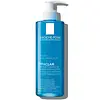What's inside
What's inside
 Key Ingredients
Key Ingredients

 Benefits
Benefits

 Concerns
Concerns

 Ingredients Side-by-side
Ingredients Side-by-side

Water
Skin ConditioningDecyl Glucoside
CleansingButylene Glycol
HumectantLaureth-11 Carboxylic Acid
CleansingPEG-120 Methyl Glucose Dioleate
EmulsifyingGlycerin
HumectantDimethicone PEG-7 Phosphate
CleansingZinc PCA
HumectantButeth-3
SolventSodium Hydroxide
BufferingHydroxypropyl Guar Hydroxypropyltrimonium Chloride
Chlorphenesin
AntimicrobialSodium Benzotriazolyl Butylphenol Sulfonate
UV AbsorberO-Cymen-5-Ol
AntimicrobialJuniperus Oxycedrus Wood Oil
MaskingTetrasodium EDTA
Tributyl Citrate
SolventTocopherol
AntioxidantCI 42090
Cosmetic ColorantWater, Decyl Glucoside, Butylene Glycol, Laureth-11 Carboxylic Acid, PEG-120 Methyl Glucose Dioleate, Glycerin, Dimethicone PEG-7 Phosphate, Zinc PCA, Buteth-3, Sodium Hydroxide, Hydroxypropyl Guar Hydroxypropyltrimonium Chloride, Chlorphenesin, Sodium Benzotriazolyl Butylphenol Sulfonate, O-Cymen-5-Ol, Juniperus Oxycedrus Wood Oil, Tetrasodium EDTA, Tributyl Citrate, Tocopherol, CI 42090
 Reviews
Reviews

Ingredients Explained
These ingredients are found in both products.
Ingredients higher up in an ingredient list are typically present in a larger amount.
Peg-120 Methyl Glucose Dioleate is used to improve texture and stability of a product. It is sugar based and helps thicken a product.
Once applied, it also creates a thin film to trap moisture in. This helps keep your skin hydrated.
This ingredient is the polyethylene glycol ether of the diester of oleic acid and methylglucose. The 120 represents an average of 120 moles of ethylene oxide.
There is limited research on this ingredient, although it is considered safe to use in skincare products.
Learn more about PEG-120 Methyl Glucose DioleateSodium Hydroxide is also known as lye or caustic soda. It is used to adjust the pH of products; many ingredients require a specific pH to be effective.
In small amounts, sodium hydroxide is considered safe to use. However, large amounts may cause chemical burns due to its high alkaline.
Your skin has a natural pH and acid mantle. This acid mantle helps prevent harmful bacteria from breaking through. The acid mantle also helps keep your skin hydrated.
"Alkaline" refers to a high pH level. A low pH level would be considered acidic.
Learn more about Sodium HydroxideWater. It's the most common cosmetic ingredient of all. You'll usually see it at the top of ingredient lists, meaning that it makes up the largest part of the product.
So why is it so popular? Water most often acts as a solvent - this means that it helps dissolve other ingredients into the formulation.
You'll also recognize water as that liquid we all need to stay alive. If you see this, drink a glass of water. Stay hydrated!
Learn more about WaterZinc PCA (or "zinc salt") differs slightly from zinc itself. PCA stands for pyrrolidone carboxylic acid. However, Zinc PCA comes from zinc.
It can help reduce redness, regulate sebum, and promote the general healing process of the skin.
Zinc PCA tends to be especially useful for those with oily, acne-prone skin. It's certainly an ingredient worth trying out!
Learn more about Zinc PCA